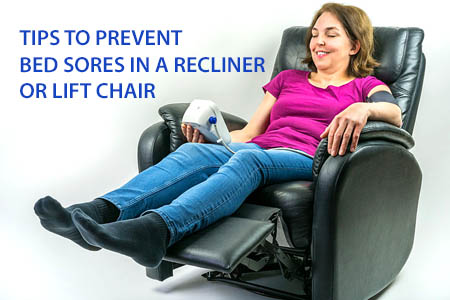Tips to Prevent & Treat Bed Sores And Pain in a Home Recliner & Lift Chair
Tips to Prevent & Treat Bed Sores And Pain in a Home Recliner & Lift Chair
For people with limited mobility, sleeping or spending their day in a hospital bed is not always possible. Comfort and care are often found at home in a home recliner or lift chair. The use of a home recliner is quite common when suffering from conditions such as ALS, Parkinson's, Congestive Heart Failure (CHF), TSCI, debilitating injury, and other conditions that limit mobility. For others, sleeping in a recliner is a more practical choice due to advanced age or obesity. Whatever the condition, limited mobility or the inability to reposition oneself increases the incidence of pressure injury AKA bedsores, and the risk of developing a potentially fatal infection such as MRSA. Below are several tips on how to help prevent and heal bedsores and help alleviate pain in a home recliner or lift chair.
FOUR MAJOR FACTORS THAT HELP PREVENT & TREAT BEDSORES IN A RECLINER
- Attain Proper Positioning
- Prevent Skin Shear & Friction
- Redistribute Pressure often
- Prevent Heat and Moisture Build-up
- Surface Immersion
PROPER POSITIONING HELPS PREVENT PRESSURE SORES
It is difficult for those who are less mobile to achieve and maintain a proper seating position in a home recliner or lift chair. Even with assistance, the patient may not be positioned properly. Due to the seat depth of many home recliners and lift chairs, patients may not be able to get far enough back in the chair to sit properly.
For patients who are 5' 9" or less, recliner seat depth can be more crucial. To sit, a patient is positioned in front of the chair with the back of the calves touching the front of the recliner seat. The patient sits or is assisted to the seated position. Once seated, there is often a gap between the patient's hips and the back of the chair. This is because the seat depth is too deep for the patient's height. To find comfort, the patient leans back without alleviating the gap. This forces them to sit directly on the tailbone or sacrum “sacral sitting”. This improper seating position can cause additional pressure on the tailbone, pain and prolonged pressure leading to skin breakdown.
Sitting upright with body weight balanced is very important. Improper balance can cause IT pain, that is pain in the Ischial Tuberosity or Sit Down Bones. Without the ability to reposition, prolonged pressure can lead to pain and skin breakdown. Since the skin is thin over the boney prominences of the coccyx, sacrum, IT, it does not take long for pain or pressure sores to develop.
POSITIONING TIPS
- One way to alleviate the gap is to make sure the patient's hips are against the back of the recliner when sitting. Repositioning the patient or the patient repositioning themselves is not ideal.
NOTE: Attaining proper position may be more difficult in a recliner due to the recliner's seat depth and the patient's height. Alleviting this gap requires patient repositioning. However, the process of repositioning can be the source of skin shear.
Ideally, with the patient's hips against the back of the chair, there should be a slight gap between the inside of the knee and the front of the recliner seat. A proper back cushion may help shorten the seat depth and improve patient positioning.
- When seated, weight is placed on the IT Ischial Tuberosity aka Sit Down Bones. If seated improperly, pressure is not evenly distributed and therefore can be the source of pain and enough pressure to restrict blood flow in the skin causing the skin to breakdown. It is essential that the patient is in a neutral seating position and not leaning. Leaning can add additional pressure.
- If possible, recline slightly. This helps off-load weight from the tailbone/coccyx to the back.
- Purchase a Pressure redistribution cushion that fits in your Recliner or Lift Chair. The cushion that you purchase depends on the severity of the pressure ulcer, the patient's ability to reposition, and long-term prognosis. (see below)
PREVENT SKIN SHEAR
When repositioning, shifting/sliding back in a recliner can create skin shear. The inability to lift one's weight off the recliner seat surface during repositioning can create injury to the skin. Skin shear occurs when the skin and underlying bones move in opposite directions. This happens when the force needed to break the friction (grab) between the patient and the recliner seat surface, moving in opposite directions, is greater than what the skin can withstand. These opposing forces can tear the skin. Sometimes this occurs on the surface and others the injury is hidden underneath the surface of the skin eventually breaking open.
Well-intentioned caregivers without the strength to off-load the patient's weight before repositioning can inadvertently cause skin shear.
TIPS TO PREVENT SKIN SHEAR INJURY
- A non-shear, low-friction cover material such as Vyvex can help prevent skin shear and friction injuries. This highly specialized material feels like human skin, is anti-bacterial, anti-microbial, stain-resistant, and fluid-proof.
- Prevent repositioning when bearing weight in a seated position
- Off-load patient weight before repositioning
- Use a slide sheet
- Use a recliner cushion with a non-shear, non-friction cover. This type of cover is present on the recliner cushions listed below.
PRESSURE REDISTRIBUTION TO PREVENT PRESSURE INJURIES
Prolonged pressure between the body and the recliner seat, especially where the bone is closest to the skin, can impede vital blood flow to the skin. In fact, the pressure between the body and the support surface exceeding capillary closing pressure will prevent blood from flowing within the skin. Blood supply to the skin is what keeps it healthy. Reducing or blocking the blood supply to the skin rapidly leads to skin cells dying and skin breakdown, aka pressure injury aka bed sores. For some, a pressure injury can occur in just 2 hours. Elderly patients with thin or brittle skin or conditions that restrict blood flow such as diabetes can accelerate the formation of pressure injuries.
TIPS TO IMPROVE PRESSURE REDISTRIBUTION
- Reposition often
- Purchase a pressure redistribution cushion for your recliner or lift chair
FACTORS TO CONSIDER WHEN PURCHASING A RECLINER CUSHION
There are many factors that determine what type of cushioning is appropriate to help redistribute pressure:
- - Are there sores
- - The stage of the sore/s (I, II, III, IV, Unstageable)
- - The location of sore/s
- - Patient mobility
- - Patient ability to reposition
- - Patient weight & height
- - Body shape
- - Does the patient lean
- - Access to care
- - More!
Below are several types of cushions that can be used in a home recliner or lift chair and when to use them
RECOMMENDED CUSHIONS FOR PRESSURE REDISTRIBUTION AND SKIN PROTECTION IN A HOME RECLINER OR LIFT CHAIR
Gel Recliner Cushion
For patients less than 250 lbs whose skin is clear, mild to moderate risk of skin breakdown and the patient is able to reposition themselves. Fluidized Gel bladders are encapsulated between a top layer of comfort foam and a supportive layer of base foam. The fluidized gel contours to your body and envelopes the boney prominences for comfort, support and pain relief. The recliner cushion is for those of low to moderate risk of skin breakdown and who can reposition themselves.
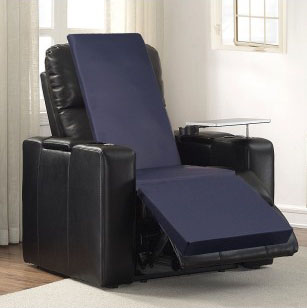
COMFORT & PAIN RELIEF
For People under 250 lbs with Low to Moderate Risk of Skin Breakdown
- Excellent Support and Comfort for those under 250 lbs
- Fluidized gel seat & back
- Foam heel wedge
- Head-to-heel comfort and pressure redistribution
- Those who are at Low to Moderate Risk of Skin Breakdown
- Available in 2.5" height
- A variety of widths 18", 20", 22" & Custom
- Fits all home recliners & lift chairs
- Safety straps and non-skid bottom hold cushion in place
- Healthy CerfiPUR-US certified foam, virtually no odor
Gel-Flex™ Bariatric Recliner Cushion
For patients over 250 lbs up to 1000 lbs. whose skin is clear, mild to moderate risk of skin breakdown and the patient is able to reposition themselves. Gel-Flex™ features a flexible semi-solid Blue Gel that provides excellent pressure redistribution. Gel-Flex™ combines the therapeutic benefits of Gel-Flex™ with a CertiPUR US certified PPF™ polyurethane foam. This combination provides uncompromising pressure redistribution and comfort while providing superior support for bariatric patients. Cushions constructed with Gel-Flex™ have a lower sag factor (deflection) and longer life cycle.
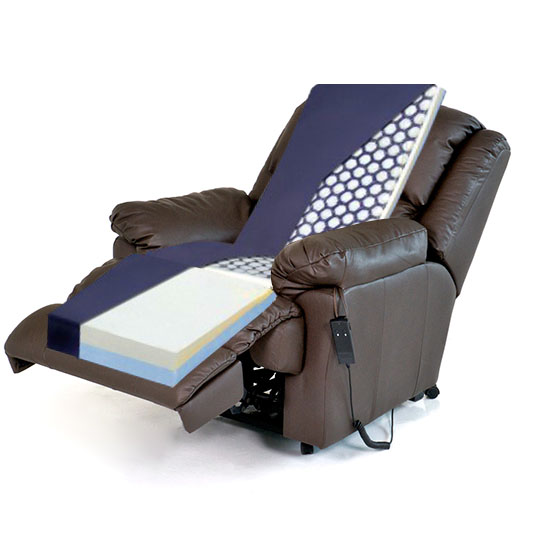
BARIATRIC COMFORT & PAIN RELIEF
For People More than 250 lbs with Moderate Risk of Skin Breakdown
- Excellent Support and Comfort for those over 250 lbs
- Superior head-to-heel comfort and pressure redistribution
- Those who are at Moderate Risk of Skin Breakdown
- Available in 3", 4" & 5" heights
- A variety of widths 20", 22", 24", 29"& Custom
- Fits all home recliners & lift chairs
- Safety straps and non-skid bottom hold cushion in place
- Healthy CerfiPUR-US certified foam, virtually no odor
- Can be made to support 350 lbs - 1000 lbs
Recliner-Air Recliner Overlay
Alternating Pressure Seat / Fluidized Gel Back / Foam Heel Wedge - Prevention and healing with alternating pressure in the seat only. For patients whose skin is affected with an early stage to moderate stage bedsore on their bottom and the patient has limited ability to reposition themselves. The back is a fluidized gel for pressure redistribution and the heel wedge is foam to help prevent heel ulcers
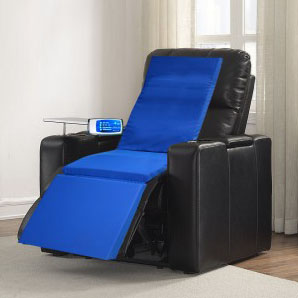
PREVENT & TREAT STAGES I-III PRESSURE SORES
Comfort & Pain Relief for Moderate Risk of Skin Breakdown
- Alternating Pressure Therapy in SEAT ONLY
- Adjustable Comfort in seat
- For people at Moderate Risk of Skin Breakdown
- Available in a variety of widths 18", 20", 22", 24" & Custom
- Fits all home recliners & lift chairs
- Ultra-quiet Pump
- Safety straps and non-skid bottom hold cushion in place
- Fluidized Gel Back, Foam Heel Wedge
- Sit or Sleep
- Supports up to 250 lbs.
Memory Foam Recliner Cushion
Memory Foam is a heat activated Visco-elastic foam developed by NASA for space flight. This pad utilizes the healthiest CertiPUR-US certified foam, made without heavy metals and formaldehyde. The foam in the recliner overlay is virtually odor free. The specific density of the overlay has been tested and chosen for its superior comfort and pressure redistribution properties. For patients at low risk for skin breakdown who are able to reposition themselves without assistance.
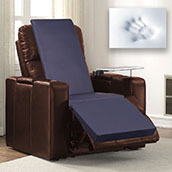
SUPERIOR COMFORT & PAIN RELIEF
For People at Low Risk of Skin Breakdown
- Heat activated foam cradles your body
- Superior head-to-heel comfort and pressure redistribution
- For people at Low Risk of Skin Breakdown
- Available in a variety of widths 18", 20", 22", 24" & Custom
- Fits all home recliners & lift chairs
- Safety straps and non-skid bottom hold cushion in place
- Healthy CerfiPUR-US certified foam, virtually no odor
- Supports up to 250 lbs
Alternating Pressure Recliner Overlay
This is the FIRST AND ONLY alternating pressure recliner cushion specifically developed for home recliners and lift chairs. Alternating pressure therapy not only provides pressure redistribution, it helps to improve blood flow to the skin. This same therapy is utilized by the finest hospitals in the world for the advanced prevention and treatment of Stages I-IV pressure injuries. The low shear, low friction anti-microbial anti-bacterial cover helps prevent skin shear.
This Alternating Pressure Recliner cushion is recommended by wound care professionals for their patients as well by medical professionals and therapists for use in long term care facilities as well as in home care across the US.
The 9700 GRLB-4401 is so effective, it was chosen and promoted by the medical staff at VA Hospitals as an innovative product for the prevention and treatment of pressure ulcers in a home recliner or lift chair.
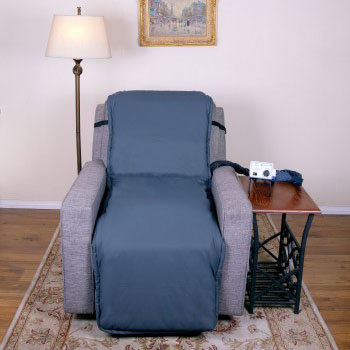
PREVENT & TREAT STAGES I-IV PRESSURE SORES
Advanced Pain Relief & Comfort for High Risk of Skin Breakdown
- Alternating Pressure Therapy
- Low Air Loss
- Varying depth air bladders to contour to the body
- 3.5" seat depth to provide immersion
- Adjustable Comfort
- For people at High to Medium Risk of Skin Breakdown
- Low Shear, Low Friction, Anti Microbial Multi-stretch Cover
- Available in a variety of widths 18", 20" & 22"
- Fits all home recliners & lift chairs
- Ultra-quiet Pump
- Safety straps and non-skid bottom hold cushion in place
- Head-to-heel protection
- Sit or Sleep. Can be used 24/7 365
- Supports up to 250 lbs. Bariatric Model Available
- - Bubble style alternating pressure pads (BUBBLE STYLE PADS WILL NOT WORK).
- - Cushions of the same size air bladders that do not coutour to the natural curves of the body
- - Cushions without low air loss
There are many factors that can lead to the development of a pressure ulcer. The tips above are some of the more common yet addressable issues that can help maintain healthy skin.
None of the information above is meant as medical advice or to be used to diagnose or treat a pressure wound. Always seek the assistance of a medical professional or seating specialist.
About the Author:
Jeff Adise has been in the wound care industry for over 28 years. He is a product specialist and the developer of innovative therapeutic support surfaces for the treatment and healing of Stages I-IV pressure injuries in home recliners, lift chairs, wheelchairs, and beds. His innovative products are recommended for use by wound care specialists, physicians, caregivers, disease-related organizations for conditions such as ALS, across the US. In addition, Jeff is working with a team of Doctors and Ph.D. researchers to develop an Investigational New Drug shown to greatly improve the quality and speed of wound healing while reducing infection.
Contact
e-mail: jeff@comfortsbest.com
tel: 888 450-0045


